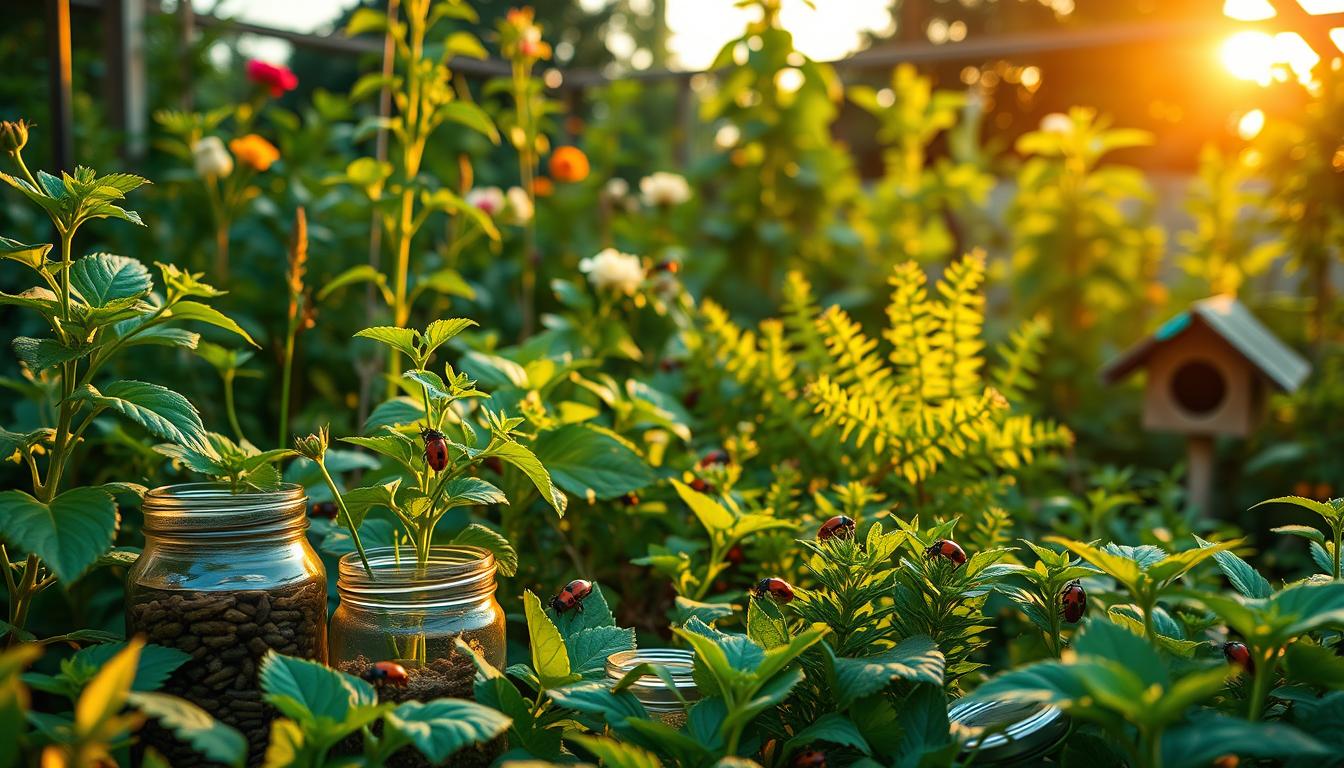Gardening is a joy that brings fresh food to our tables. But, unwanted visitors can quickly ruin this pleasure. Many gardeners turn to chemical sprays when bugs show up, not knowing about gentler, natural ways to protect plants.
Natural solutions work with your garden’s ecosystem, not against it. Choosing eco-friendly pest solutions helps protect bees and ladybugs. These insects are your allies in keeping plants healthy.
Using chemical-free methods keeps harmful substances away from your family, pets, and food. Your soil stays healthy, supporting stronger plants that resist problems better.
Creating balance in your garden is simple and doesn’t need special skills or expensive products. Basic, time-tested techniques can manage bugs while nurturing a thriving outdoor space. The natural approach is better for the environment and makes your garden more resilient and productive for years.
The Hidden Dangers of Chemical Pesticides
Chemical pesticides promise to keep gardens pest-free but hide dangers. Many gardeners use them without knowing the long-term effects. These chemicals may solve immediate problems but can cause lasting issues.
Environmental Impact of Synthetic Chemicals
Chemical pesticides don’t stay in one place. Rain and water wash them into waterways, polluting streams and groundwater. They can stay in soil for years, breaking down into harmful compounds.
Wildlife outside your garden also suffers. Birds, beneficial insects, and fish are harmed by these chemicals. Using eco-friendly pest control helps protect these ecosystems.
Health Risks for Humans and Pets
Chemical pesticides are dangerous to families and pets. Children are more vulnerable because of their developing immune systems. Even careful use can leave residues on food that washing can’t remove.
Pets are also at risk from direct contact or eating treated plants. Many pesticides have been linked to serious health problems in humans and animals.
Disruption of Garden Ecosystems
Chemical pesticides disrupt the natural balance in gardens. They harm both pests and beneficial insects that control pest numbers.
Without these natural helpers, pest problems can get worse. This leads to a cycle of needing more chemicals. Eco-friendly pest control keeps these allies, making gardens stronger and more resilient.
Why Organic Pest Control Matters for Modern Gardeners
Organic pest control is more than just avoiding chemicals. It’s about creating harmony in our gardens. As we learn more about our impact on the environment, our choice of pest control matters a lot. It’s a shift from fighting nature to working with it.
Organic methods use natural systems, making gardens stronger and more resilient. They do more than just avoid chemicals. They help create thriving ecosystems in our backyards.
Preserving Beneficial Insects
Organic pest control protects beneficial insects. Chemical pesticides harm everything, but organic methods target pests without harming good bugs.
Pollinators like bees and butterflies are key for growing food. They help produce over 35% of the world’s crops. Predatory insects like ladybugs and mantises eat pests, keeping gardens healthy.
By keeping these insects, gardens become self-regulating. Nature does most of the pest control for us.
Building Soil Health
Healthy soil is the base of a strong garden. Organic pest control doesn’t harm soil like chemicals do. It helps the soil ecosystem thrive.
Soil full of life makes plants stronger and less vulnerable to pests. It’s like an underground network that warns plants of dangers.
Organic practices build a garden’s immune system. Plants grow stronger and need less help over time.
Creating Sustainable Garden Systems
Organic pest control fits with sustainable gardening. It tackles the root of pest problems, not just symptoms.
These methods make gardens self-sufficient and balanced. Many gardeners see pest problems decrease as their garden reaches a healthy state.
Working with nature, not against it, brings joy to gardening. It turns gardening into a partnership with nature.
| Aspect | Conventional Pest Control | Organic Pest Control | Long-term Impact |
|---|---|---|---|
| Beneficial Insects | Often killed alongside pests | Protected and encouraged | Natural pest control increases over time |
| Soil Health | May degrade with repeated use | Improved through organic practices | Enhanced plant immunity and vigor |
| Ecosystem Balance | Disrupted, creating dependency cycles | Maintained and strengthened | Self-regulating garden systems |
| Gardener Experience | Reactive, often frustrating | Proactive, educational | Deeper connection with natural processes |
Choosing sustainable pest control doesn’t mean giving up on your garden. It’s a smarter way to garden that works with nature. Your garden will be beautiful, good for the environment, and need less care over time.
Understanding Garden Pest Cycles
Effective natural pest control starts with knowing when pests show up, grow, and get weak. Working with nature’s cycles is key. This way, gardeners can use the right organic controls at the best times.
Imagine being a detective in your garden. Watching pest patterns lets you solve problems before they get big. This approach keeps your garden balanced and healthy.
Knowing pest cycles helps you tell real threats from harmless visitors. Many insects that look scary are actually helpful or just passing through.
Identifying Common Garden Pests
First, you need to know what pests look like. Aphids are tiny and cluster on new growth. Tomato hornworms are big, green, and have a horn.
Spider mites make fine webs on leaves, causing yellow spots. Squash bugs are flat and gray, sucking plant juices. Cabbage loopers eat holes in brassica leaves.
Pest Life Cycles and Vulnerabilities
Pests go through four stages: egg, larva, pupa, and adult. Each stage is a chance to control them. Larvae are often easier to kill than adults.
Timing is everything. Biological controls work best at certain stages. For example, nematodes target larvae, while diatomaceous earth kills adults.
Seasonal Pest Patterns
Pests follow the seasons. Spring brings aphids and cutworms. Summer is spider mites and squash bugs. Fall has cabbage worms and stink bugs.
Weather affects pests too. Warm, wet springs boost aphids. Drought favors spider mites. By watching these patterns, you can manage pests better.
Prevention: The Foundation of Organic Pest Control
Prevention is key in non-toxic pest control. It’s not just the first step, but the base of the whole strategy. By designing your garden with pest management in mind, you can cut down on later interventions. Think of it as giving your garden ecosystem immunity, where plants grow well and pests find it hard to get a foothold.
Preventative strategies work with nature, not against it. They use natural plant relationships, timing, and barriers to keep your garden balanced. These methods blend into your garden’s design and care, making pest control a part of gardening, not a chore.
Companion Planting Strategies
Companion planting is nature’s way of creating plant communities that support each other. This ancient practice pairs plants that help each other grow and naturally keep pests away. The right pairs can turn your garden into a balanced ecosystem where beneficial insects flourish and pests are kept in check.
Best Plant Combinations
Some plant pairs are great for non-toxic pest control. Tomatoes and basil together repel tomato hornworms and improve flavor. Carrots and onions confuse carrot flies with the onion scent. Cucumbers and nasturtiums make a good pair, with nasturtiums trapping aphids and cucumber beetles.
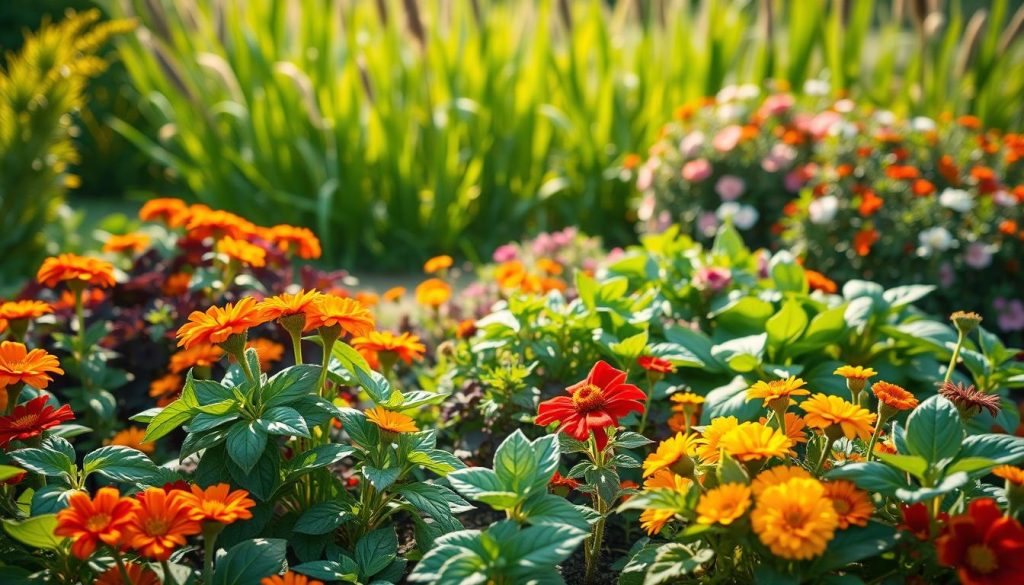
The “Three Sisters” of corn, beans, and squash are a classic Native American planting system. Corn supports beans, beans fix nitrogen, and squash’s leaves shade the ground, preventing weeds and pests.
Repellent Plants
Some plants naturally keep pests away. Marigolds repel nematodes and attract beneficial insects with their bright flowers. Nasturtiums draw aphids away from vegetables and add edible flowers.
Aromatic herbs like rosemary, thyme, and mint confuse pests with their strong scents. Garlic and chives repel aphids, Japanese beetles, and spider mites. These plants protect your garden and add beauty and diversity.
Crop Rotation Techniques
Crop rotation breaks pest cycles by changing what grows where each season. Many pests and diseases target specific plant families. Rotating crops disrupts these cycles without chemicals.
A basic four-year rotation system divides plants into families: legumes, brassicas, solanaceae, and alliums. Moving each family to a different bed each year prevents pests and diseases from building up in the soil.
Keep a garden journal to track your rotations. Even small gardens benefit from rotating between a few beds. This approach also balances soil nutrients, as different plants have different needs.
Physical Barriers and Traps
Simple solutions can be the most effective for non-toxic pest control. Physical barriers stop pests before they reach your plants. Floating row covers protect crops from flying insects while still allowing plants to grow.
Copper tape keeps slugs and snails away from raised beds and containers. The copper reacts with their slime, creating a mild shock that deters them. Diatomaceous earth is a powder that cuts through insect exoskeletons but is safe for humans and pets.
Strategic traps can reduce pest populations while monitoring them. Yellow sticky cards capture whiteflies, aphids, and fungus gnats. Beer traps lure slugs and snails to a harmless end. Pheromone traps can monitor and reduce specific pests like codling moths in apple trees.
By using these preventative measures, you create a garden that naturally resists pests. These approaches make pest control a part of your garden design, making it beautiful and pest-resistant.
Building Healthy Soil for Natural Pest Resistance
The secret to fighting pests in organic gardens isn’t a spray or trap. It’s the healthy ecosystem of the soil. Plants grown in nutrient-rich soil have stronger immune systems. They naturally resist pests.
Soil is more than just dirt. It’s the foundation of your garden’s health. When plants get balanced nutrition from living soil, they make compounds that keep pests away. These compounds help plants grow stronger and defend themselves.
Composting for Soil Health
Compost is key to building healthy soil. It adds nutrients and beneficial organisms that help your garden fight pests. Making your own compost turns kitchen scraps and yard waste into powerful plant food.
- Green materials (nitrogen-rich): vegetable scraps, coffee grounds, fresh grass clippings
- Brown materials (carbon-rich): dried leaves, small twigs, paper, cardboard
- Occasional water to maintain moisture like a wrung-out sponge
- Regular turning to incorporate oxygen
Beneficial Microorganisms
The soil is home to billions of tiny helpers. These microbes work to protect your plants. They form relationships with roots, exchanging nutrients for sugars.
Mycorrhizal fungi help roots reach more water and nutrients. They also make antibiotics that fight diseases. Beneficial nematodes and protozoa eat pest larvae, keeping the soil balanced.
Organic Soil Amendments
Compost is just the start. Specific organic amendments offer more benefits. Worm castings add nutrients and microbes, improving soil structure. They also have chitinase, which breaks down insect exoskeletons.
Seaweed extracts give plants trace minerals and growth hormones. Rock dust minerals add essential elements for plant defense. Biochar helps microbes and holds water in sandy soils.
By focusing on living soil, you’re not just growing plants. You’re building an underground ecosystem that fights pests.
Harnessing Beneficial Insects
Many gardeners focus on getting rid of pests. But the smartest way is to recruit beneficial insects. These natural allies help control pests without harming your garden. By supporting these creatures, your garden can manage itself, needing less help and growing healthier.
Beneficial insects are predators and parasitoids. Predators eat pests, and parasitoids lay eggs inside pests. Both are key to keeping your garden balanced.
Ladybugs: The Aphid Destroyers
Ladybugs are well-known for eating aphids, scale insects, and mites. One ladybug can eat up to 5,000 aphids in its lifetime. They are very good at controlling pests.
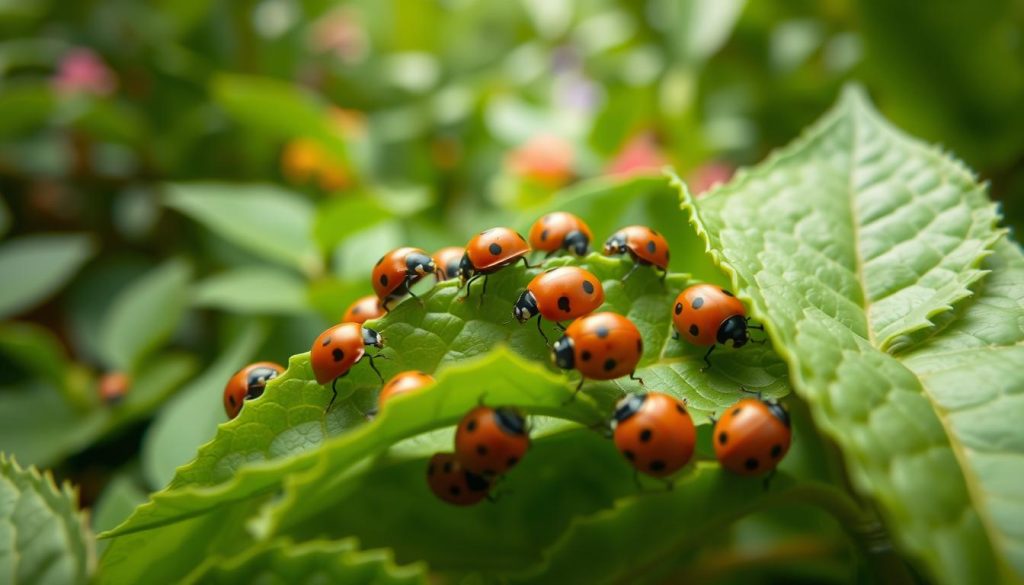
To attract ladybugs, plant dill, fennel, and yarrow. These flowers give ladybugs the pollen and nectar they need. Avoid using broad-spectrum insecticides, as they can harm ladybugs too.
When buying ladybugs, release them in the evening after misting your garden. This helps them stay. Make your garden welcoming with water and shelter to keep ladybugs around.
Predatory Wasps and Flies
Most predatory wasps are not aggressive to humans but deadly to pests. Parasitic wasps, like Trichogramma and Braconid, lay eggs inside pests. Their larvae then eat the host from the inside, controlling pest populations.
Hover flies, with their yellow and black stripes, are great garden helpers. Their larvae eat aphids, thrips, and caterpillars. Adults also pollinate flowers. One hover fly larva can eat hundreds of aphids.
To attract these insects, plant herbs like thyme, oregano, and mint. These plants provide landing spots and nectar for adult wasps and flies, helping with pest control.
Creating Habitats for Beneficial Insects
Attracting beneficial insects is just the start. You also need to provide them with reasons to stay. Diverse habitats in your garden ensure these insects thrive all year.
Insect Hotels
Insect hotels offer shelter for beneficial insects like solitary bees, lacewings, and ladybugs. You can make them simple or elaborate. Include various materials and hole sizes for different species.
Use hollow stems, wood blocks, pinecones, and cardboard to make your insect hotel. Place it in a sunny spot, facing south or southeast. Make sure it’s dry and near flowers for food.
Water Sources
Beneficial insects need water to survive. Use shallow dishes with pebbles or cork pieces for safe drinking spots. Place these water sources near flowers and insect hotels.
Keep water sources clean by refreshing them often. In hot summer months, add more water stations to support increased insect activity.
| Beneficial Insect | Target Pests | Attracting Plants | Benefits to Garden |
|---|---|---|---|
| Ladybugs | Aphids, scale insects, mites | Dill, fennel, yarrow, cosmos | Consume up to 5,000 aphids per lifetime |
| Parasitic Wasps | Caterpillars, aphids, whiteflies | Sweet alyssum, herbs, umbel flowers | Parasitize pests, preventing reproduction |
| Hover Flies | Aphids, thrips, small caterpillars | Mint, oregano, thyme, chamomile | Larvae eat pests, adults pollinate |
| Ground Beetles | Slugs, snails, cutworms, root maggots | Ground cover, leaf litter, mulch | Night hunters that protect seedlings |
| Lacewings | Aphids, mealybugs, spider mites | Caraway, angelica, coreopsis | Larvae consume 200+ aphids weekly |
By using these biological pest management strategies, your garden becomes a balanced ecosystem. This approach reduces the need for intervention and makes your garden more resilient and sustainable over time.
Botanical Pesticides: Nature’s Defense Arsenal
Botanical pesticides are a safer choice for gardeners. They come from nature and are effective against pests. These plant-based solutions break down quickly, making them better for the environment.
Plants have natural defenses against insects and disease. We can use these defenses to protect our plants. Botanical pesticides are specific, targeting pests without harming beneficial insects.
Using botanical pesticides wisely is key. They should be used sparingly and as part of a larger pest control plan. Timing is important to avoid harming pollinators and beneficial insects.
Neem Oil Applications
Neem oil is a versatile natural insecticide. It comes from the neem tree and disrupts pest life cycles. It repels, deters feeding, regulates growth, and sterilizes insects.
To use neem oil, mix 2 teaspoons of concentrate with 1 teaspoon of soap in 1 quart of water. Spray it on plants, covering all surfaces where pests hide. Apply every 7-14 days during the growing season for prevention.
Apply neem oil in the early morning or evening. Avoid spraying in the heat of the day to prevent leaf burn and protect pollinators. Neem breaks down quickly, but use it thoughtfully to protect beneficial insects.
Pyrethrin-Based Solutions
Pyrethrins are insecticidal compounds from chrysanthemum flowers. They attack the nervous systems of insects, providing quick control. Unlike synthetic pyrethroids, natural pyrethrins break down in sunlight within 24-48 hours.
Pyrethrins are broad-spectrum, affecting both pests and beneficial insects. Apply in the evening to target pests and avoid harming pollinators. Use them for severe infestations when other methods fail.
Essential Oil Formulations
Essential oils are gentle yet effective botanical pesticides. Oils like peppermint, rosemary, clove, and thyme repel or disrupt pest behavior. They work as repellents and contact insecticides, making them great for prevention.
To make an essential oil spray, mix 10-15 drops of oil with 1 cup of water and 1/4 teaspoon of soap. Different oils target different pests. Peppermint deters ants and aphids, while rosemary controls cabbage moths and carrot flies.
Essential oil sprays need frequent application but are safe for most beneficial insects. They are best used as part of a prevention strategy, not for severe infestations.
| Botanical Pesticide | Target Pests | Application Frequency | Environmental Persistence | Impact on Beneficials |
|---|---|---|---|---|
| Neem Oil | Aphids, whiteflies, mites, scale | 7-14 days | 3-4 days | Low when used correctly |
| Pyrethrins | Beetles, caterpillars, flies | As needed | 1-2 days | Moderate – use with caution |
| Essential Oils | Varies by oil type | 3-5 days | 1 day or less | Very low |
| Garlic Spray | Aphids, beetles, borers | Weekly | 2-3 days | Very low |
| Diatomaceous Earth | Crawling insects | After rain/irrigation | Until washed away | Low-moderate (physical barrier) |
DIY Organic Pest Control Recipes
Turn kitchen items into garden protectors with these DIY pest control recipes. Making your own natural insecticides saves money and lets you control what’s in your garden. These homemade solutions can be as good as store-bought ones if done right. Plus, you might already have these ingredients in your kitchen!
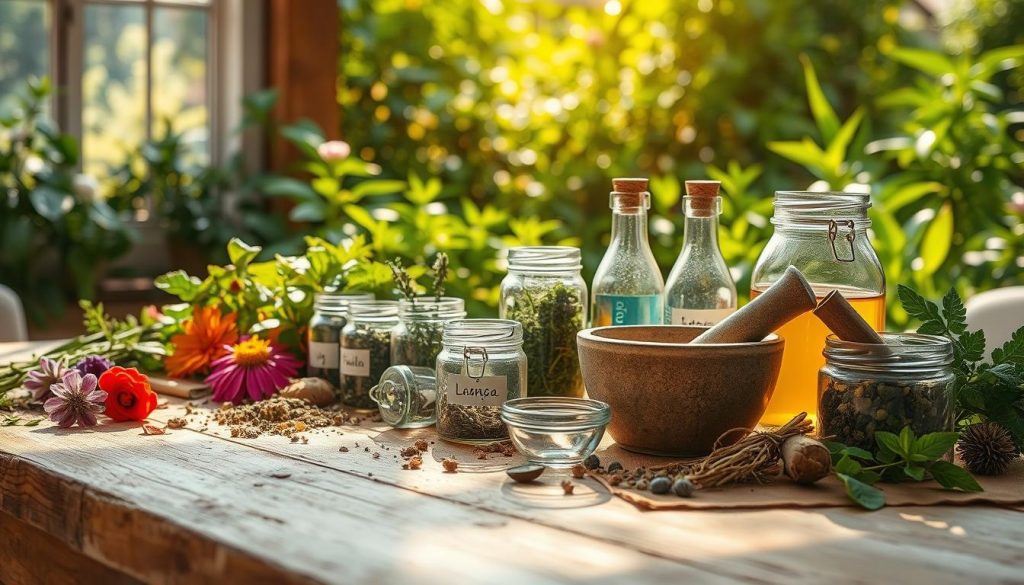
Garlic and Hot Pepper Sprays
Garlic and hot peppers keep many pests away. To make a garlic spray, blend 4-5 cloves with 2 cups of water, then strain it. Add one hot pepper for extra power.
For best results, spray in the morning or evening when fewer beneficial insects are around. Use it on both leaf sides where pests hide. Reapply after rain or every 7-10 days during peak pest season.
Keep unused spray in the fridge for up to a week. Its strong smell fades fast but keeps aphids, spider mites, and caterpillars away.
Soap-Based Insecticides
Soap solutions harm soft-bodied insects like aphids and whiteflies. Mix 1-2 tablespoons of pure castile soap or insecticidal soap with one quart of water.
Test the soap solution on a small plant section first. Wait 24-48 hours to see if it harms the plant before using it more. Spray it directly on pests for the best results.
Don’t use dish soaps with degreasers or detergents. They can hurt plants. Pure castile soap or insecticidal soaps are safe and effective when diluted right.
Vinegar Solutions for Garden Pests
Vinegar is great for pest control and weed killing. Mix 1 part white vinegar with 3 parts water and add a teaspoon of mild soap. This solution fights ants, slugs, and soft-bodied insects.
For tough weeds, use equal parts vinegar and water. But be careful not to harm good plants with vinegar.
Apple cider vinegar makes effective fruit fly traps. Fill a container with apple cider vinegar and add a drop of dish soap. Place these traps near fruit or veggies to catch flies before they lay eggs.
Always label your homemade insecticides and keep them away from kids and pets. These solutions are safer than chemicals but still need careful handling and application.
Integrated Pest Management for Organic Gardens
Integrated Pest Management changes how you deal with pests in your garden. It’s not just about fighting pests; it’s about working with nature. This method uses prevention, observation, and intervention to keep your garden healthy.
With IPM, you learn about your garden’s ecosystem. This knowledge helps you tackle pest problems wisely. It saves time, money, and keeps your garden balanced.
Monitoring and Identification Techniques
Regular checks are key to effective IPM. Spend time each week inspecting your plants. Look closely at leaf undersides, stem joints, and new growth.
Using simple tools can help. Yellow sticky traps catch flying pests like whiteflies and fungus gnats. Blue sticky traps are better for thrips. Place these around your garden to track pests and spot problems early.
Keep a garden journal to record what you see. Note pest sightings, beneficial insect activity, weather, and plant health. These notes help you spot patterns and prevent future problems.
Establishing Action Thresholds
Understanding when to act is crucial in IPM. Not every pest problem needs a solution. Your garden can handle some pests without damage.
For ornamental plants, think about how much damage you can tolerate. For edible crops, consider both quantity and quality. A few holes in kale might be okay, but cabbage loopers in broccoli are a problem.
Some pests are good for beneficial insects. A small aphid population might attract ladybugs. Setting thoughtful thresholds helps avoid unnecessary actions that upset your garden’s balance.
Combining Multiple Control Strategies
IPM’s strength is in using many approaches together. Instead of one solution, mix different strategies to fight pests from all sides.
Start with cultural practices like spacing and watering. Add physical controls like row covers or hand-picking. Use biological controls by attracting beneficial insects. Use botanical pesticides last, when other methods fail.
This layered approach makes your garden resilient. If one method doesn’t work, others will keep pests under control. Your garden can face challenges without falling apart.
| IPM Strategy Type | Examples | Best For | Implementation Timing |
|---|---|---|---|
| Cultural Controls | Crop rotation, resistant varieties, proper spacing | Prevention of pest problems | Planning and planting stages |
| Physical Controls | Row covers, sticky traps, hand-picking | Blocking pest access to plants | Early season or at first sign of pests |
| Biological Controls | Beneficial insects, nematodes, microbial products | Ongoing pest suppression | Preventatively or at early infestation |
| Botanical Controls | Neem oil, pyrethrin, essential oil sprays | Targeted pest reduction | When thresholds are exceeded |
By using IPM, your garden becomes a living ecosystem. It takes more effort at first but leads to a garden that needs less help over time.
Tackling Specific Garden Pests Naturally
Different garden pests need different natural solutions. General organic practices help your garden stay healthy. But, some pests need special attention. Eco-friendly pest solutions work with nature, keeping your garden balanced.
Aphid Control Strategies
Aphids are tiny sap-suckers that grow fast. A strong water blast can remove them from plants. Ladybugs and lacewings eat hundreds of aphids every day.
Plant garlic, chives, and marigolds to keep aphids away. For tough cases, use neem oil spray weekly. It stops aphids from reproducing without harming good bugs.
Combating Caterpillars and Worms
Butterfly larvae can harm crops. Look for chewed leaves and dark droppings to find them. Hand-picking and dropping them in soapy water works well.
For big problems, use Bacillus thuringiensis (Bt). It kills caterpillars but not other insects. Spray it on leaves where eggs are laid.
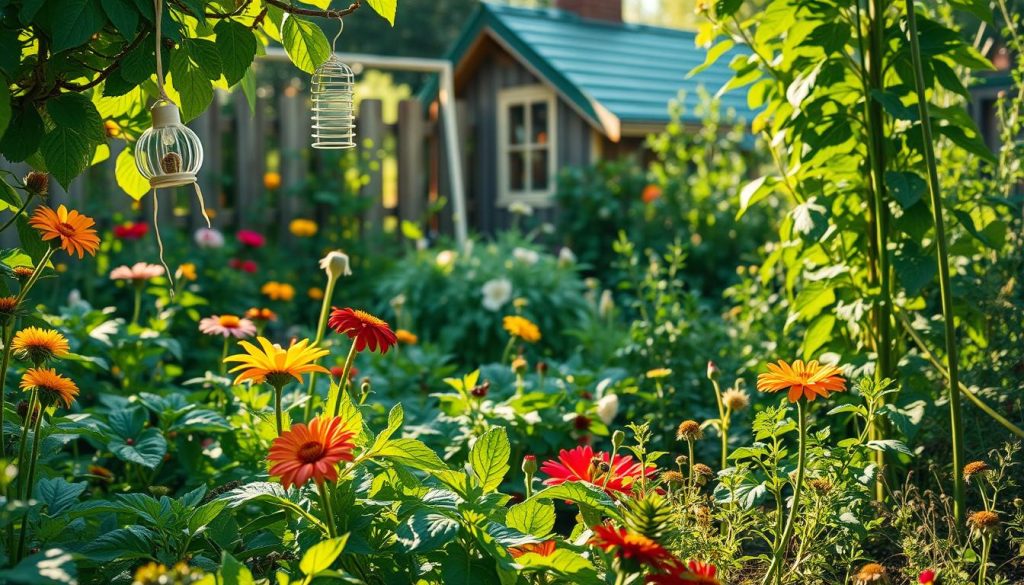
Managing Slugs and Snails
Slugs and snails leave silver trails and holes in leaves. Copper tape around beds stops them. Diatomaceous earth is a sharp barrier that won’t harm pets or animals.
Beer traps are great for catching slugs. Bury a container with beer, and they’ll fall in. Empty and refill it often for best results.
Dealing with Spider Mites
Spider mites love hot, dry places and make webbing. Mist plants to keep them moist. Predatory mites like Phytoseiulus persimilis target them without harming plants.
For quick relief, spray plants with neem oil and soap. Focus on the undersides of leaves. Spray weekly until the problem goes away.
Natural Solutions for Whiteflies
Whiteflies cause yellow leaves and sticky honeydew. Yellow sticky traps catch adults. Plant diverse flowers to attract natural predators.
Use insecticidal soap to target nymphs. Neem oil also works well. Keep monitoring and acting early to control whiteflies.
| Pest Type | Identification Signs | Natural Predators | Preventative Measures | Organic Treatments |
|---|---|---|---|---|
| Aphids | Clusters of tiny insects on new growth, sticky honeydew | Ladybugs, lacewings, parasitic wasps | Companion planting with chives, garlic | Strong water spray, neem oil, insecticidal soap |
| Caterpillars | Chewed leaves, dark droppings on foliage | Birds, parasitic wasps, ground beetles | Row covers during egg-laying season | Hand-picking, Bt spray, diatomaceous earth |
| Slugs/Snails | Silvery trails, irregular holes in leaves | Ground beetles, birds, toads | Copper barriers, gravel mulch | Beer traps, diatomaceous earth, eggshell barriers |
| Spider Mites | Fine webbing, stippled yellowing leaves | Predatory mites, ladybugs | Regular misting, adequate watering | Neem oil spray, insecticidal soap, horticultural oil |
| Whiteflies | Tiny white insects that fly when disturbed | Lacewings, hoverflies, parasitic wasps | Yellow sticky traps, reflective mulch | Insecticidal soap, neem oil, garlic spray |
Seasonal Organic Pest Control Calendar
Creating a seasonal calendar for pest control helps you stay proactive. It lets you tackle problems before they start. This approach reduces stress and makes gardening easier by spreading tasks evenly.
By following nature’s cycles, you’ll spend less time fighting pests. You’ll have more time to enjoy your garden.
Spring Preventative Measures
Spring is key for a pest-free garden. Start by testing and improving your soil. Healthy soil means healthier plants, which resist pests better.
Clear out winter debris to stop pests from hiding. Keep areas for beneficial bugs safe. Use row covers and copper tape to protect seedlings. Release beneficial insects like ladybugs early to control pests.
Apply neem oil to fruit trees when they’re dormant. Set up monitoring stations to catch pests early.
Summer Maintenance Strategies
Summer is when pests are most active. Check your garden weekly, looking at both sides of leaves. Use a garden journal to track pests and find problem spots.
Water in the morning to avoid fungal diseases. Treat pests quickly with targeted methods. Keep soil and mulch levels right to help plants during heat.
Harvest often to keep produce from attracting pests.
Fall and Winter Preparation
Fall cleanup is important. Remove sick plants but keep some areas for beneficial insects. Lightly till the soil to disrupt pests, then add compost.
Plant cover crops to stop erosion and weeds. Clean and fix tools in winter. Use this time to plan for next year’s pest control. Order supplies early for spring.
Embracing the Organic Garden Ecosystem: A Path to Sustainable Gardening
When you start using organic pest control, something amazing happens. Your garden starts to balance itself. It becomes a strong, connected system that needs less help over time.
Starting an organic garden isn’t always easy. You might face problems when natural sprays don’t work fast. You might lose some plants while learning. These are normal parts of the journey.
The benefits are huge. Your soil gets better. Beneficial insects come back and do well. Plants grow strong on their own. The food you grow is free of chemicals. This way of gardening makes your garden alive and productive.
Begin with just one or two organic gardening tips. Start with companion planting or a homemade spray. As you get better, add more to your gardening tools. Each success brings you closer to a fully organic garden.
Organic gardening isn’t about being perfect. It’s about working with nature. Seeing pests as a chance to make your garden stronger makes gardening fun and sustainable. Your garden becomes a source of food and a healthy ecosystem for our planet.

